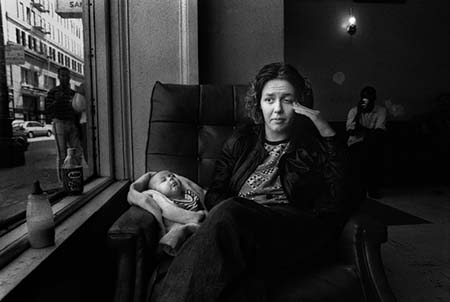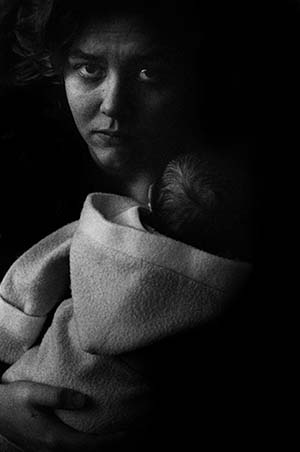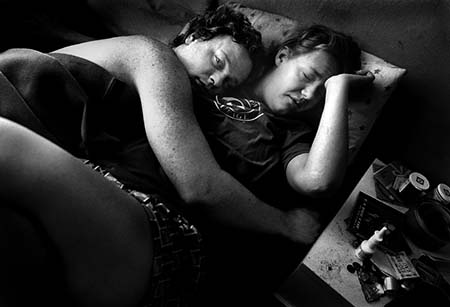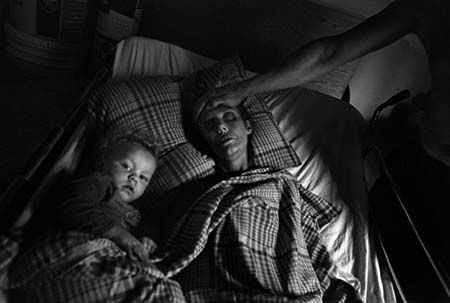The first time I saw Darcy Padilla's photographs of Julie Baird, I was critical. Often raw and sharp, they showed the subject's misery with an insistence that left no space for reflection. The images defied my ability to observe: the cluttered rooms, the dirty children, Judy's frail, deteriorating body, her relentless hardships. Even more so: Julie's eyes as she neared the end of her life. They didn't have a gaze. I couldn't detect any attempt to filter the tragedy through any kind of protective screen. I thought the photographer had faltered in her role as witness, fallen into the easy trap of sensationalism. A paparazzo of misery.
Julie with her 3 month old daughter Rachel in the lobby of the Hotel Ambassador in San Francisco, where they lived. Both Julie and her partner are seropositive, Julie says "Rachael gave us a reason to live." San Francisco, California, USA. 1993.
This was before I saw the photographs in their chronological order. Before I read Darcy's personal notes or the transcriptions of her phone conversations with Julie in the 18 years they knew each other. The reciprocal dialogue between images and words counterbalanced the brutality of the pictures, and gave them a perspective of meaning capable of unfolding the project's complexity. And flooded it with humanity.
Darcy's first intention was to tell the story of a poor, AIDS-stricken woman fighting for survival. Her situation seemed to represent a marginalized fringe of American society. Her life looked like a sequence of misfortunes capable of bringing up the looming threat of social determinism. An alcoholic mother, raped by her stepfather since the age of six, ran away from home at 14, became a drug addict at 15, contracted HIV at 19, had six children from three different men --five of whom were taken away from her and given up for adoption, got arrested for kidnapping her newborn son from child protection services -- state benefits, extreme poverty, AIDS.
Julie with her 3-month-old daughter Rachel in the lobby of the Hotel Ambassador in San Francisco, where they lived. San Francisco, California, USA. 1993.
Julie Baird's story arose from a casual encounter in the lobby of a run-down hotel in San Francisco, back in 1993. Darcy Padilla, then 26, was documenting the work of a group of doctors and social workers who took care of AIDS patients who couldn't afford hospital care. Julie, 19, was barefoot, holding an eight-day-old newborn in her arms. During her pregnancy she discovered she had contracted HIV from Jack, her partner and the boy's father. From that moment on, and for the next 18 years, Darcy Padilla photographed Julie constantly, following her through the changes and misfortunes she endured until she died of AIDS in September 2010.
But the documentation of this story became more than an umpteenth portrayal of the crushing problems linked to poverty and drug abuse in the United States. A sincere compassion emerged from the initial sociological approach as the photographer, from behind her lens, shared her own humanity and was haunted by this constant interrogation: "How does a child, who came to the world as any other, becomes Julie Baird?".
As Julie was bringing up her children, perpetuating the negligence that she herself had suffered, a desire for redemption emerged, which manifests itself in her children. Because of her sporadic drug addiction, five of them were abruptly taken away from her: Rachel, Tommy, Ryan, Jordan, Jason Jr., and Elyssa. Along with shaking her viewers' conscience and sensitizing them to stories like Julie's, the photographer's main thought goes out to these children, hoping the documentation of their mother's life will help them understand their own stories, as adults.
Julie and her partner Jason after being released by the police. They were arrested for taking away their newborn son from the hospital where Julie gave birth. The State of California withdrew the parents' custody rights because Julie tested positive for drugs. San Francisco, California, USA. 2000.
I understood that Darcy applied W. Eugene Smith's advice to the fullest "(...) become neighbors and friends instead of journalists." A casual encounter and the desire to examine urban poverty, gave way to a mutual understanding which impacted the lives of both Julie and Darcy. Thanks to Darcy, Julie was reunited with her father, who had been trying to find her for 31 years -- ever since her 17-year-old mother fled with her from Alaska to San Francisco after an argument. After Julie's story was published on Darcy's website, the adoptive mother of one of Julie's children contacted her to reestablish contact between Julie and little Zach (Jason Jr.).
I think the strength of this project lies in Darcy Padilla's ability to deepen her perspective through her bond with Julie, to humanize her through the details of her life story, and to add a personal lens to the denunciation, acknowledging the debt she owed to her disarmingly available subject. W. Eugene Smith said, "Most photographers seem to operate behind a glass which separates them from their subjects. They are unable to get in contact with them to know them." Darcy Padilla went beyond that dividing line, and remained on the other side of it for almost 20 years, telling Julie's story even after her death. In fact, in 2011 she returned to Alaska to find Jason, Julie's partner, and Elyssa, the only child who remained in their custody. The two now live in Oregon with Jason's family.
On September 5, 2010 Julie is discharged from the hospital. She is said to be "preparing for the end of her life..." She received AIDS treatment at home and is resting in her bed. Her daughter, Elyssa, 2 years old, is nestled in the bed next to her. Alaska, USA. 2010.
After showing in Lodi last April, The Julie Project, by American photographer Darcy Padilla, will come to Rome for the first time on September 28, 2012, at 10b Photography on via San Lorenzo da Brindisi 10/b, as part of the 2012 edition of Fotoleggendo. It is a difficult project -- one that manages to restore trust in documentary photography, to confirm its complexity and its importance. The exhibit will be open through November 2, and the entire project can be viewed on Darcy Padilla's web site.
The Julie Project has received many recognitions, including (not coincidentally) the Eugene Smith Memorial Fund Grand for Humanistic Photography, the Getty Images Grant for Editorial Photogaphy, and a World Press Photo award. Photos of Jason and Elyssa's difficult life in a house without water or electricity at the edge of an Alaskan forest, earned honorable mention in the Daily Life section of World Press Photo 2012 edition.



